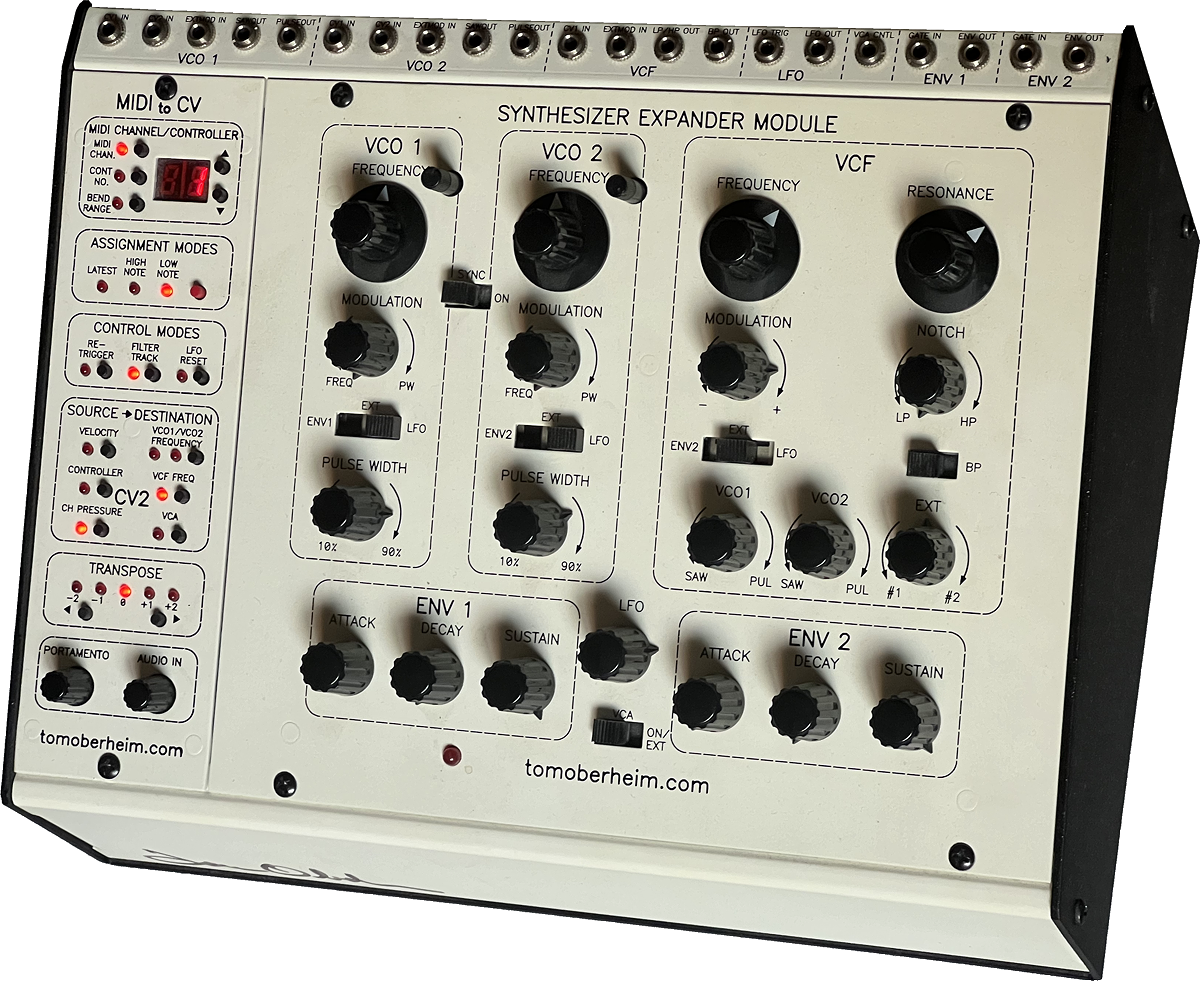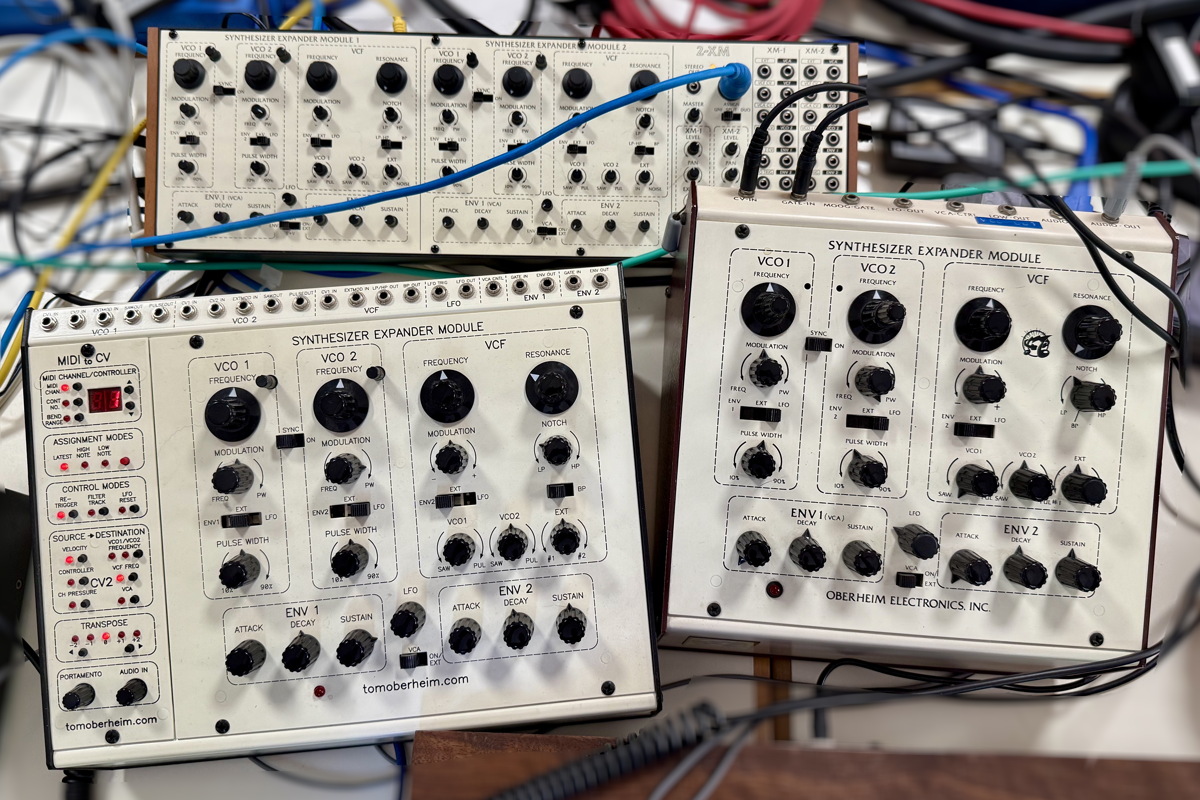Tom Oberheim SEM-Pro

This is Synthesizer Expander Module is the 2009 version of the 1974 SEM-1. It combines most patch points of the SEM Patch Panel version and the SEM MIDI to CV features in one housing. It was produced in lower numbers from 2011 on. It got Tom Oberheim's signature on the vertical front.
The housing is steady metal. The concentric axis of the VCO course and fine tuning of the original 70ies version were not used in this reincarnation. There is a course tuning knob about the size of the original version. The fine tuning is a black pot axis to the top right of the course tuning knob. I guess, starting to get a low number of these concentric double pot was just too expensive or simply unavailable to source. The full CCW switch of the filter mode pot is changed to a switch below the pot. All these changes are minor and should not effect the sound or the handling of this synth.
As Tom Oberheim was not allowed to use his own name due to the lost of the trademark rights for "Oberheim", he had his company named Marion System Cooperation ("Marion" is the first name of his wife). But he used bold letters to emphase his domain name tomoberheim.com. Later Tom Oberheim was given back his trademark of his family name by Behringer, the last owner of this trademark.
The original SEM-1 was not the result of just Tom's sole work. While he set the feature set and the user interface. Jim Cooper (if you were into synth in the early eighties, you know his name) designed the circuity. Dave Rossum (of E-mu and SSM) helped with the VCO design. Dennis Colin of ARP designed the multimode filter.[1]

While the MIDI to CV part let you route either MIDI CC, velocity or (monophonic) aftertouch to the filter, pitch or VCA, it is not possible to route the modwheel of a MIDI controller like a keyboard to the LFO modulation amount. But you may use the modwheel CC to change the filter cutoff.
There is last, high and low note assignment (= note priority) modes on the MIDI to CV panel. And while last note priority is selected, you may switch retriggering the envelopes with each new key played on or off. The later gives allows you to bind notes by playing legato without restarting the envelope. In the other note priorities it is always defaults no retriggering (= single trigger). So the setting of low note priority is the way a original Minimoog works. You have to let all keys go before you are able to change the note priority.
If you don't us the external audio in #2 socket, turning up the EXT #2 volume gives you a 440 Hz note A tuning reference tone. This is very handy to tune the oszillators, if you use the course frequency knob for setting the oscillators to different octaves (as there is no footage switch for the oscillators). For transposing both oszillators to different octaves, there is a +2 to -2 Octaves transpose on the MIDI to CV panel.
The backside connections are, except of the MIDI sockets and the power socket (24 V DC, 300 mA negativ on the outside), are 6.35 mm (1/4") in size. The one of the top rim of the panel are all 3.5 mm (1/8").

At the summer 2025 private Happy Keys gathering here in Tübingen/Germany, we connected a vintage Oberheim SEM (thanks to HaJo), a Tom Oberheim SEM Pro and the Behringer 2-XM clone to the Synthesizers.com Keyboard QKB15 (it delivers CV & Gate plus MIDI). After a bit of warming up and tuning, we first checked the row single VCO sounds with the filter fully opened. They are real close. Just the Behringer 2-XM was missing a bit of "lifeliness". You would only notice this in this comparison, not under normal playing. Next we tuned the second VCO to the same slow detuning beating, and turned the filter by ear to the same static cutoff. No gib differences. Only the Behringer knob was a bit in a different angle at the real Oberheims. Some was true for the added resonance. The envelopes are not 100% identically, but if not used in extreme settings, you will hardly ever notice a difference unless in this special comparison. But when we set up some real usable sounds, we noticed the problem of the LFO rate knob of the Behringer. It is too tiny to set with great detail by small amounts. And this pot is acting different from both Oberheims: the LFO in fully CCW position is way slower than the real Oberheims. And when you try to set it to a normal vibrato of something like 4-6 Hz, the pot will rather suddenly change the rate to higher levels. There is no smooth change from very slow to normal vibrato possible. It is a matter of maybe 5° of pot tuning to do this. You may think, this is a problem of this unit only, but we heard about other Behringer 2-XM having the very same experience.
So all in all, the two Oberheims are like identical twins. And the Behringer is just a bit different. And besides the problem we had with setting the LFO rate, and the tiny pots for other parameters like the envelopes, the Behringer is real close enough for all musical usage. And the price tag is th only major difference.
And we noticed also, when using all three units with CV, that they are all well calibrated, Much better we expected. And the original SEM we used was never recalibrated in the last 50 years. That is long lasting top quality.
[1]: from "Manual for the Synthesizer Expander Module 'MIDI to CV' version"; Chapter 10: "History of the SEM"